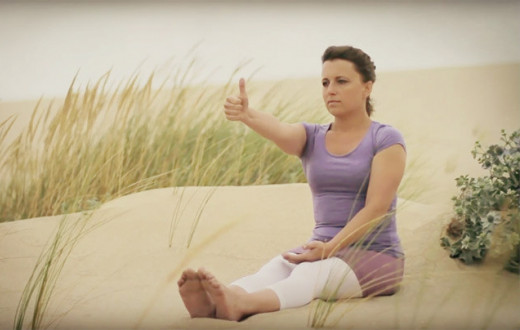By Sriram Sarvotham┃Posted: May 23, 2019
A few days ago, I read the New York Times article on yoga titled “How Yoga Can Wreck Your Body.“ I would like to share my thoughts upon reading the article.
I am reminded of the wisdom when we receive twenty compliments and one negative remark, the mind usually holds on to the one negative remark. To put the article in perspective, I feel we should acknowledge the 5,000+ year history of yoga, its extraordinary contribution to humanity, and the experiences of millions of people who have benefited from yoga.
Like all powerful tools and techniques, yoga practices should be used in the way they were intended in order to reap true benefits. A kitchen knife is a very useful tool, but it can cause harm when used without care or awareness. The concluding sentence of the New York Times article captures this sentiment very well: “If you do it (asanas) with ego or obsession, you’ll end up causing problems.”
The problem with focusing on asanas
Over the last few decades, especially in the west, the focus has been exclusively on asanas (postures). It’s a common mistake to use the word “yoga” to mean “yoga asanas” because the practice of asanas is only a tiny fraction of yoga practice. Only 3 of the 196 aphorisms of the classic yoga text “Yoga Sutras” authored by Maharishi Patanjali deal with asanas. In the end, I believe the negative article will be a reminder for all yoga practitioners that obsession with asanas isn’t a good thing. There’s much more to yoga.
The classic yoga literature is filled with insightful wisdom about the mind, offers numerous meditation techniques, describes the subtle chakras (energy centers) in the system, reveals astounding secrets of the breath and much, much more. The effectiveness of yoga (not just asanas) has also been recognized in healing and therapy. One of the definitive books on yoga therapy, titled “Yoga as Medicine,” has been authored by Timothy McCall, M.D., who is quoted in the article. It would be a tragedy if we lost the wisdom of yoga (don’t worry – it won’t happen!).
Even in the 3 sutras where Patanjali talks about asanas, he does not mention flexibility or contortionism. He defines asana as simply a stable and comfortable body position (Sutra II-46: “Sthira sukham asanam”). Further, Patanjali suggests releasing the struggle or excess effort and allowing the body to relax in the pose and enjoy the bliss (Sutra II-47: “Prayatna shaitilya ananta samapattibhyam”).
The holistic practice of yoga as taught by Patanjali includes 8 limbs (aspects) of which asana is just one. The primary concern isn’t the body at all. For example, Patanjali gives 5 sutras on pranayama (loosely translated as breath-work), perhaps suggesting that breath-work is more important than asanas! The 8 limbs also includes the living of values like non-violence, truthfulness, non-stealing, cleanliness, contentment, self-awareness, etc. Note that ruthless determination to push the body into a new pose is a form of violence and therefore goes against the principles of yoga.
The 8 limbs of yoga
The goal of the 8 limbs of yoga is to bring harmony to the body, breath, mind, etc., in order that we may live as good human beings and express our full potential. Specifically, Patanjali mentions in his sutra (II-28) that the practice of this holistic yoga removes impurities, elevates one’s awareness, and sharpens our discrimination (more on this sutra is here).
Many of the most highly revered yogis are not exactly famous for agile and flexible bodies. For example, Paramahamsa Yogananda, the celebrated author of “Autobiography of a Yogi” dedicated his life to yoga; his teachings of kriya yoga (that have come down from a long list of eminent yogis) have touched millions of lives.
Patanjali describes yoga practice as an expression of seva (service). (Sutra I-14: “Satu Dhirgha Kala Nairantarya Satkara Sevito Drdha Bhumih”). Our yoga practice is a way to serve the cells of the body, serve the inner faculties (mind, intellect, etc.) and most importantly, to serve the divinity that resides within each one of us.
It’s true that much of what happens in the name of yoga today (especially in the west) can be described as a relentless pursuit to perfect more postures and contort the body in weird ways! The seva bhaav (spirit of serving) seems to be forgotten. However, I wonder if the culprit is yoga? Or is it how we (ab)use the teachings of yoga and suffer the unpleasant consequences?
Yoga’s natural, healthy inspiration
Most of the asanas are inspired from nature. Some asanas are named after animals; for example, the cat stretch is said to have been inspired by observing the movements of a cat to bring vitality to the spine. No animal overdoes a stretch; there’s no competition, and it’s just an expression of pure joy! The animals seem to be much more in tune with the body’s innate intelligence. We humans seem to have lost this connection, thanks to stress and sedentary habits. One of the goals of yoga asanas is to learn to listen to the body more keenly and be in tune with our innate body’s intelligence.
It’s no coincidence that eminent yogis who have practiced Hatha Yoga live long and healthy lives, actively practicing and teaching till the very end. Yogacharya T. Krishnamacharya lived over 100 years; his students Indra Devi (lived till 102) and Pattabhi Jois (lived to 94) were active until their last days.
Yogacharya B.K.S. Iyengar, who is now 93, is still passionately teaching yoga. Watch this inspiring video interview of him with Prannoy Roy. I especially like the dialogue at time 1:57 to 2:20, where Prannoy Roy says that Iyengar looks more healthy and vibrant at 90 years old than anyone else in the room (the people in the audience were mainly university students).
To summarize, I’d say that we can use the article to remind ourselves of the true aims of yoga. Yoga offers deeper & much more meaningful practices than just asanas. Yes, yoga can be harmful when it’s used in ways not intended, or when we practice it with lack of awareness. However, as they say, “don’t throw the baby with the bathwater,“ even if the baby is 5,000 years old!
“Like a flower bud, human life has the potential to blossom fully.
Blossoming of human potential to fullness is yoga.”
~ Gurudev Sri Sri Ravi Shankar
This article was originally published on Sriram’s Blog and is re-posted here with the author’s permission.
Shriram Sarvotham, a yoga teacher since 1991, holds a Ph.D. degree in Electrical Engineering from Rice University, Houston, TX. He works in the tech industry in Silicon Valley California.





























